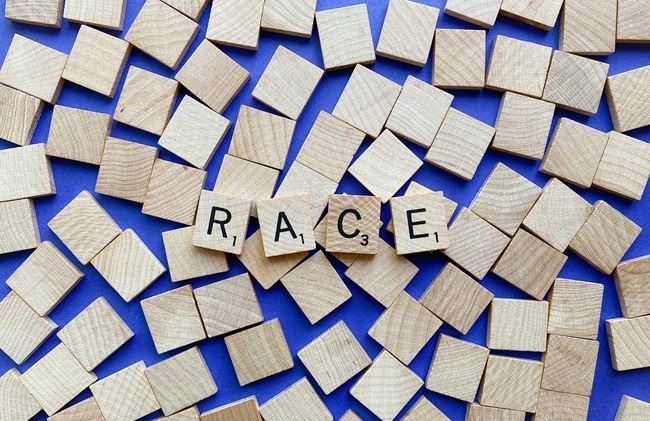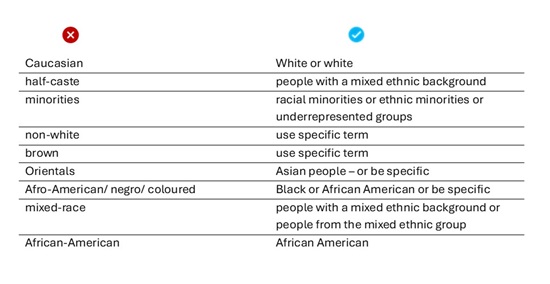
While language can be a tool for inclusion and empowerment, it can also exclude and discriminate. As language professionals, we need to stay up to date with changing conventions to ensure our writing and editing is inclusive and respectful.
But this can be harder than we think.
The way we talk about race and ethnicity has changed a lot in recent years, and it’s been driven by movements like Black Lives Matter and a growing awareness of the importance of inclusive language.
So where do we start?
Race and ethnicity
A key aspect of inclusive language is recognizing the difference between race and ethnicity.
Race refers to physical differences that groups consider socially significant based on characteristics like skin or hair colour, physical features and ancestry. For example, people might identify their race as Aboriginal, Black, Asian or White.
Ethnicity refers to a group of people who share common cultural characteristics such as language, ancestry and beliefs. For example, people might identify as Latino or Hispanic. The term ethnicity is more comprehensive and practical, and it is the way that most countries prefer to distinguish groups.
It is important to pay attention to how people describe themselves and to be clear when referring to racial or ethnic groups.
Black with a capital B
The capitalization of ‘black’ and ‘white’ in reference to racial or ethnic identity has sparked intense debate. After George Floyd was killed, some US style guides that had previously recommended using lowercase changed their stance. ‘The Associated Press Stylebook’ and ‘APA Style’ recommend capitalizing the word Black. They explain that this choice reflects a recognition of the cultural and historical significance of Black identity and acknowledges the shared experiences of Black communities worldwide.
‘White’ is typically not capitalized in most style guides. The rationale for this is to avoid reinforcing notions of white superiority or exceptionalism. Some style guides, like ‘The Chicago Manual of Style’, suggest capitalizing the W in 'White'.
In the UK, the ‘Guardian and Observer style guide’ states that it is acceptable to use the term ‘black’ in lowercase when used as a physical descriptor. However, ‘if a subject, writer or editor of a story prefers to use Black then that choice should be respected.’
Most style guides recommend not to use colours such as ‘brown’ to refer to human groups as this is considered pejorative.
What about hyphens?
The hyphens in racial and ethnic identifiers can imply a sense of otherness. Henry Fuhrmann, former editor of the Los Angeles Times, was behind successful efforts to remove them. In 2019, he tweeted: ‘As a legacy, “hyphen killer” is not bad.’
Today, many style guides advocate for not using hyphens with terms such as African American. Hyphens are not needed even when the names act as unit modifiers, e.g. ‘Asian American participants’ not ‘Asian-American participants’. But there is debate whether to use a hyphen were the term used as an adjective, e.g. ‘French-Canadian folklore’.
Avoid stereotypes
It’s important to be mindful of the adjectives we use when describing someone’s race or ethnicity. When using qualifying adjectives, ask yourself if they are relevant. Irrelevant descriptions reinforce stereotypes or suggest exceptions to the norm. For example, phrases like ‘the articulate Mexican American professor’ can perpetuate biases.
And do not use adjectives as nouns, e.g. use ‘Asian people’ not ‘Asians’ or ‘the Asians’.
Preferred terms
Here are some problematic, outdated or offensive terms with appropriate alternatives.

People of colour: Widely used in the US but less common in Europe. This term was originally intended to be a synonym for ‘Black’, but its meaning has expanded to include any person who is not white. It is now publicly being scrutinized by rights groups.
BIPOC (Black, Indigenous, and People of Colour): This relatively new term is used to recognize the unique struggles faced by Black and Indigenous communities, including historical and systemic injustices. It acknowledges the diversity within communities of colour. However, opponents argue that it establishes an ‘us’ vs ‘them’ binary.
Commitment to inclusivity: A quick checklist
When discussing race and ethnicity, our choice of words matters.
- Be precise when talking about identities.
- Replace harmful terms with more neutral language.
- Listen to how people describe themselves and if in doubt, ask.
- Keep learning!
Stay up to date with the rapidly evolving grammatical aspects of language use around race and ethnicity. There are plenty of helpful resources to help us navigate these complex issues. ‘The Conscious Style Guide’, ‘The Diversity Style Guide’ and ‘The AP Stylebook’ are good places to start.
|
Blog post by: Claire Niven Website: www.echt-english.nl LinkedIn: echt-english |
